Menu
- Equipment
- Abrasive
- Parts
- Services
- Industries
- Resources
- Videos
- About
- Contact
- FR
Menu
Home > Shop > Sandblasting Equipment > Sandblasting Booths > Hybrid Recovery System (Pneumatic and Mechanic)
A mechanical recovery system uses a screw conveyor system and a bucket elevator to collect residual abrasive media from blasting operations and clean it through an air wash separator, which separates reusable media from dust and foreign particulate matters.
The mechanical recovery system is the ideal solution for maximizing the blaster’s productivity while minimizing required care and maintenance of the system components. Also, there are no limits when it comes to the type of blast media used in the process or the contaminants that might chip at the workpiece during operations – a mechanical system will move the dirty media mix without restrictions and at a much faster rate than a pneumatic system.
The key advantages of a mechanical abrasive recovery system:
After contact with workpieces, abrasive media falls on the floor and mixes with the blasting process by-products – paint chips, rust, scale, shattered media, solid debris, etc. The dirty media mix is then pushed through floor hoppers (excavated in the floor) or shoveled into hoppers located above the ground.
In a mechanical abrasive recovery system, the dirty media mix is conveyed by worm screws to a bucket elevator, then hauled up to an air wash media separator where light particles are separated based on their specific density through a set of adjustable air streams and deflectors. When exiting the air wash system, dust and foreign particulate matter can be collected separately, and only reusable media still in good shape is returned to the blast pot for further operations.
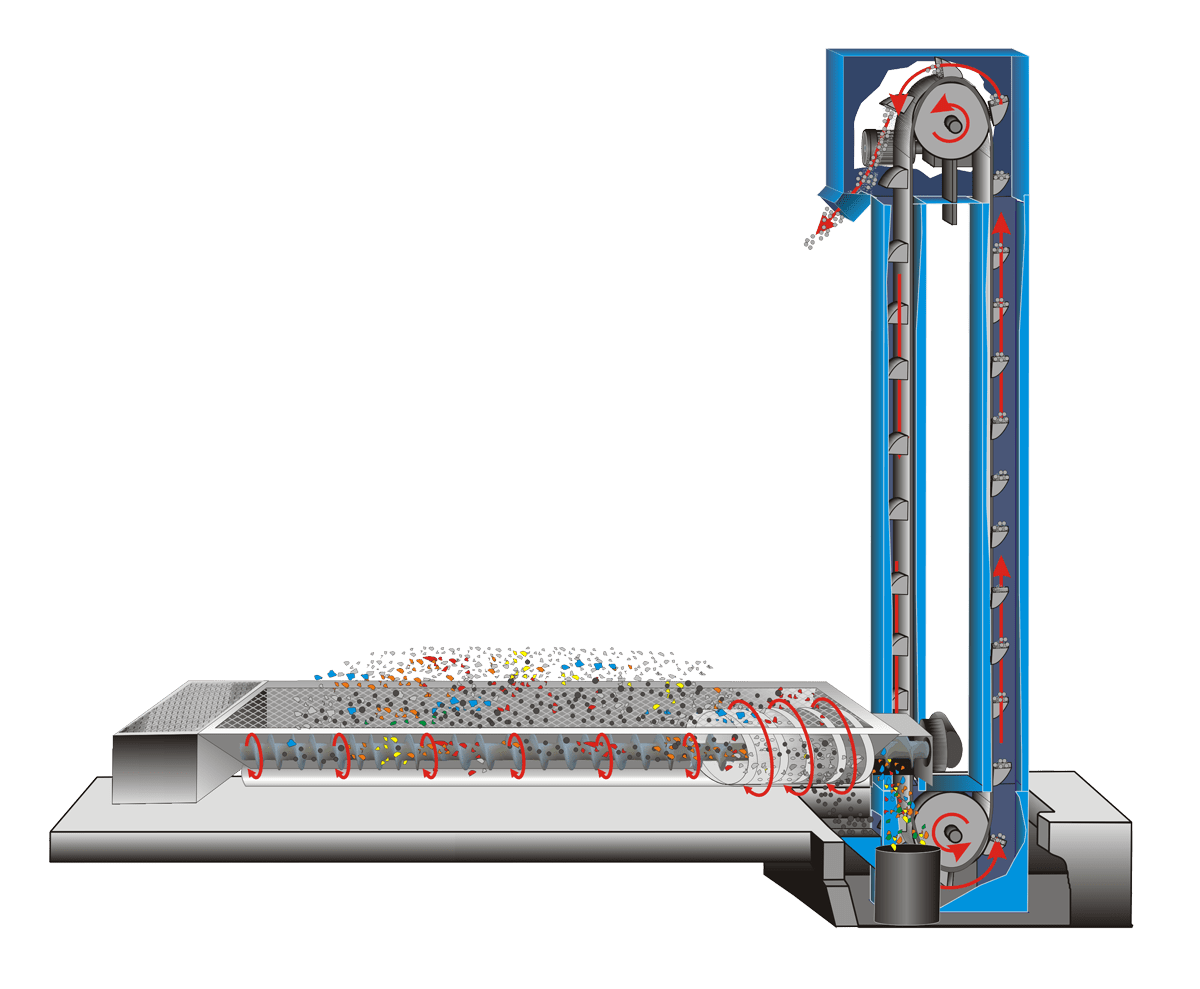 |
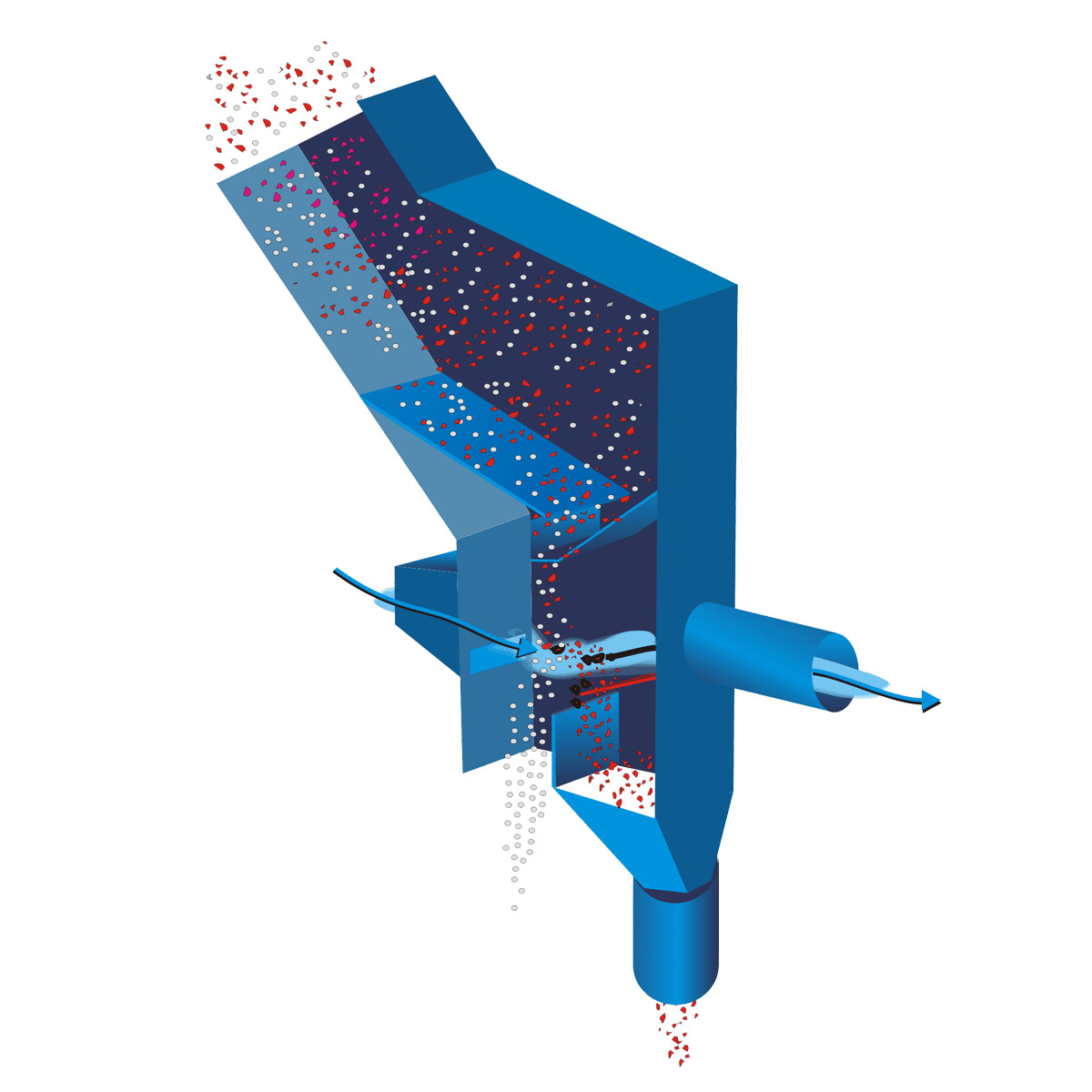 |
| Auger & Bucket Elevator | Air Wash Media Separator |
Although a mechanical abrasive recovery system is more expensive to implement than a pneumatic abrasive recovery system, it provides an exceptional return on investment when considering the overall process expenses related to downtimes, productivity, maintenance, and operation.
Let’s take a closer look at the key components of the mechanical abrasive recovery system.
The screw conveyor system collects and conveys the dirty media mix from the floor hoppers to the recycling system.

It consists of a set of long auger assemblies that move the media mix all the way to the end of the room, where the load is discharged into a bigger transverse auger assembly.
At the end of the transverse auger assembly, the whole blast booth load is then discharged into a bucket elevator after passing through a rotary screen drum to remove large debris from the dirty media mix.
The endless screw is a key component of the mechanical recovery system. Its innovative design, with only rugged parts, reduces wear and tear caused by friction with abrasive media. The auger’s shaft and steel flights are made of steel alloys specially designed to withstand incredibly heavy load demands. All ISTblast augers are built to CEMA standards.
Unlike the competition, our design consists of a direct drive 2 hp motor, on each auger independently, which rotates at a slow 2 rpm speed. This significantly reduces the blast booth’s energy consumption and eliminates the need to constantly adjust the strap on regular belt drive motors.
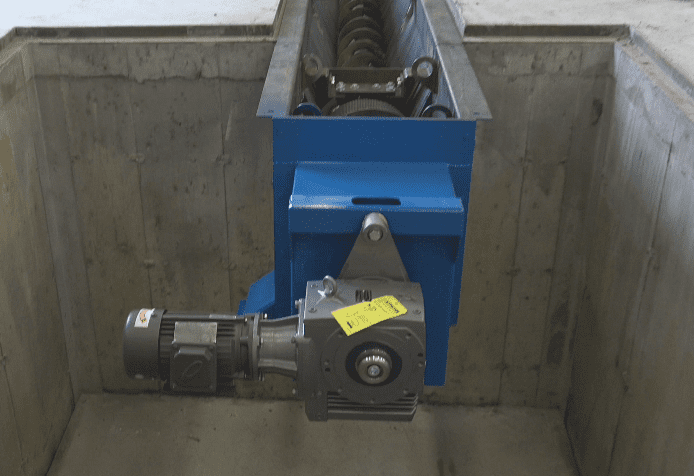
The shaft is supported by suspension brackets with steel bushings to facilitate the auger’s calibration, alignment, and maintenance. Between the shaft and the suspension bracket, friction is absorbed by the hanger bearing, which is one of the rare pieces of equipment that requires special attention in a mechanical abrasive blast facility.
Indeed, this sacrificial component needs to be replaced after several hours of operation in order to keep the screw-conveyor system in smooth running condition and avoid wearing out critical components. But no worries – it is a 10-minute job when you get used to it.
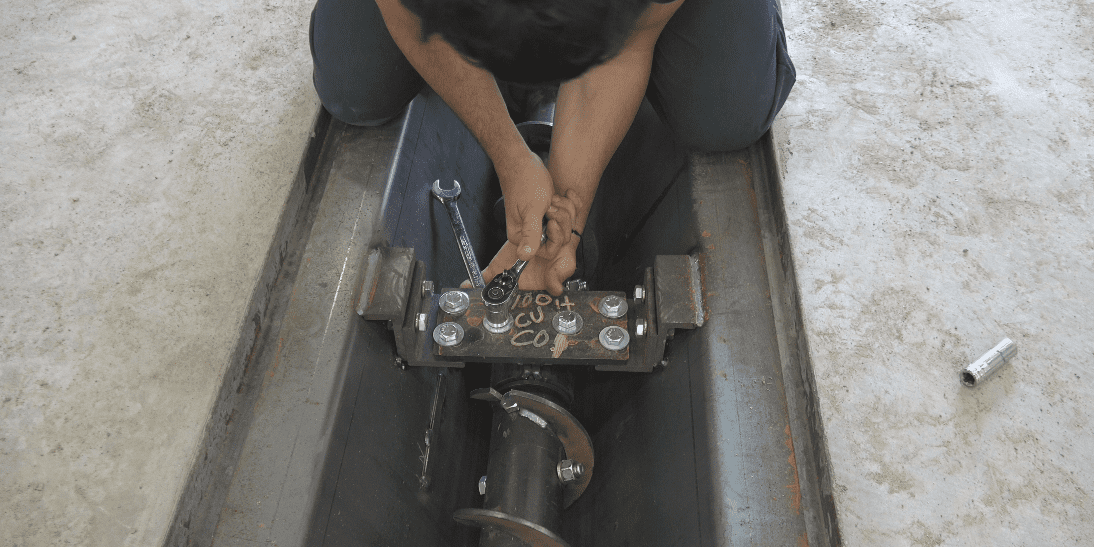
Our screw conveyor design provides self-limiting features to prevent overloading the blast recovery system at the bucket elevator during the recycling process.
The bucket elevator also has a high-level media detector to prevent overfilling the storage hopper. When the bucket elevator stops hauling, the screw conveyor stops feeding it in order to avoid overloading the recovery system.
Floor hoppers are protected by removable steel grating rated to 1,000 lbs. per square foot. Other capacities are available to allow lift trucks and other material handling equipment to circulate above.
Since the media falls freely through the grating, all contaminants can be easily conveyed by the augers without the risk of clogging the system, unlike with the pneumatic abrasive recovery system.
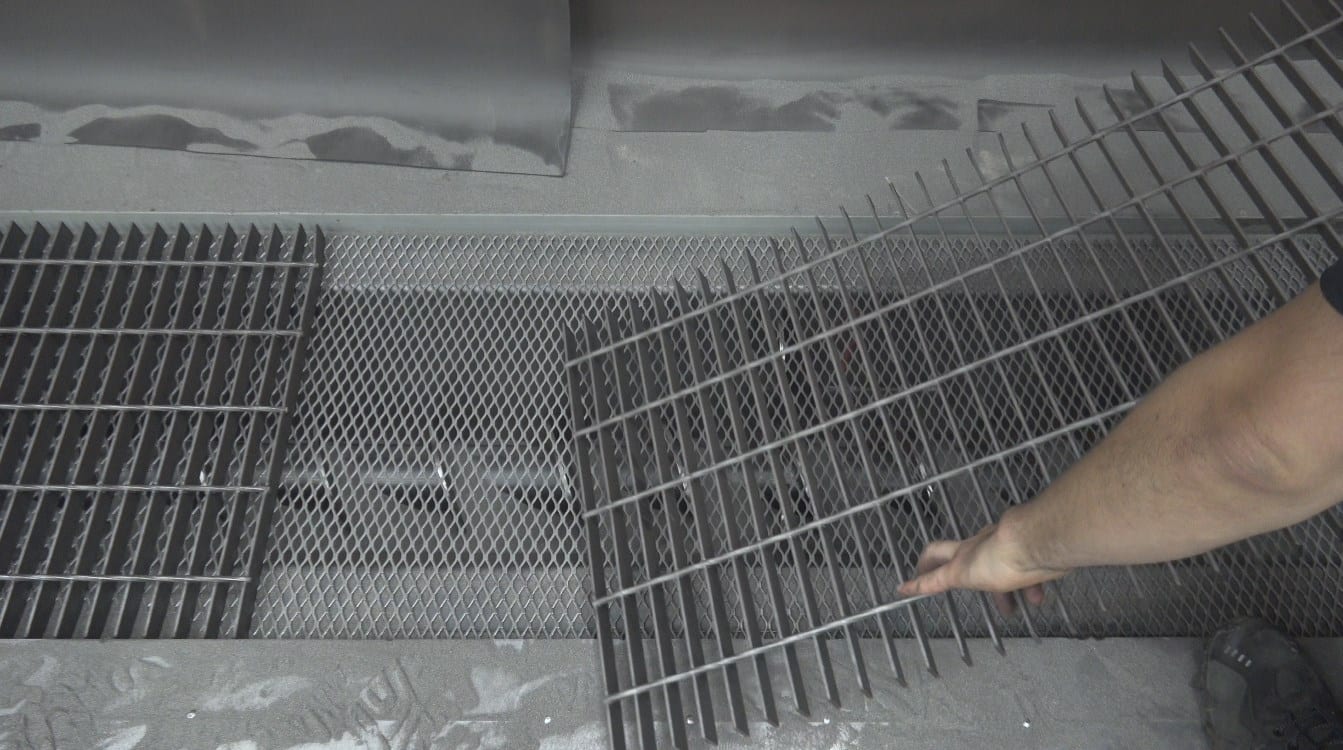
The bucket elevator collects the abrasive media discharged from the screw conveyor system and scoops it up to the air wash media separator.
The ISTblast bucket elevator is powered by two adjustable take-ups powered by a 2 HP direct drive motor. It can move abrasive media at a rate of up to 144 cubic feet per hour, without weight restrictions.
It is designed with a crowned pulley to increase the stability of the belt to run at the centre of the pulley without wobbling off from the edges, and a self-cleaning lower winged pulley to avoid abrasive media accumulation. Furthermore, it uses a worm gear to drive the pulley, which means there is no risk of reversal rotation of the bucket even when all the buckets are fully loaded with heavy abrasive media.
The bucket elevator must be excavated into a pit at least 5 ft. deep for standard installation. Down this pit, a bucket collects large debris discharged from the rotary screen drum. Alternatively, the rotary drum screen and the large debris bucket can be located on top of the bucket elevator if excavating this deep is an issue.
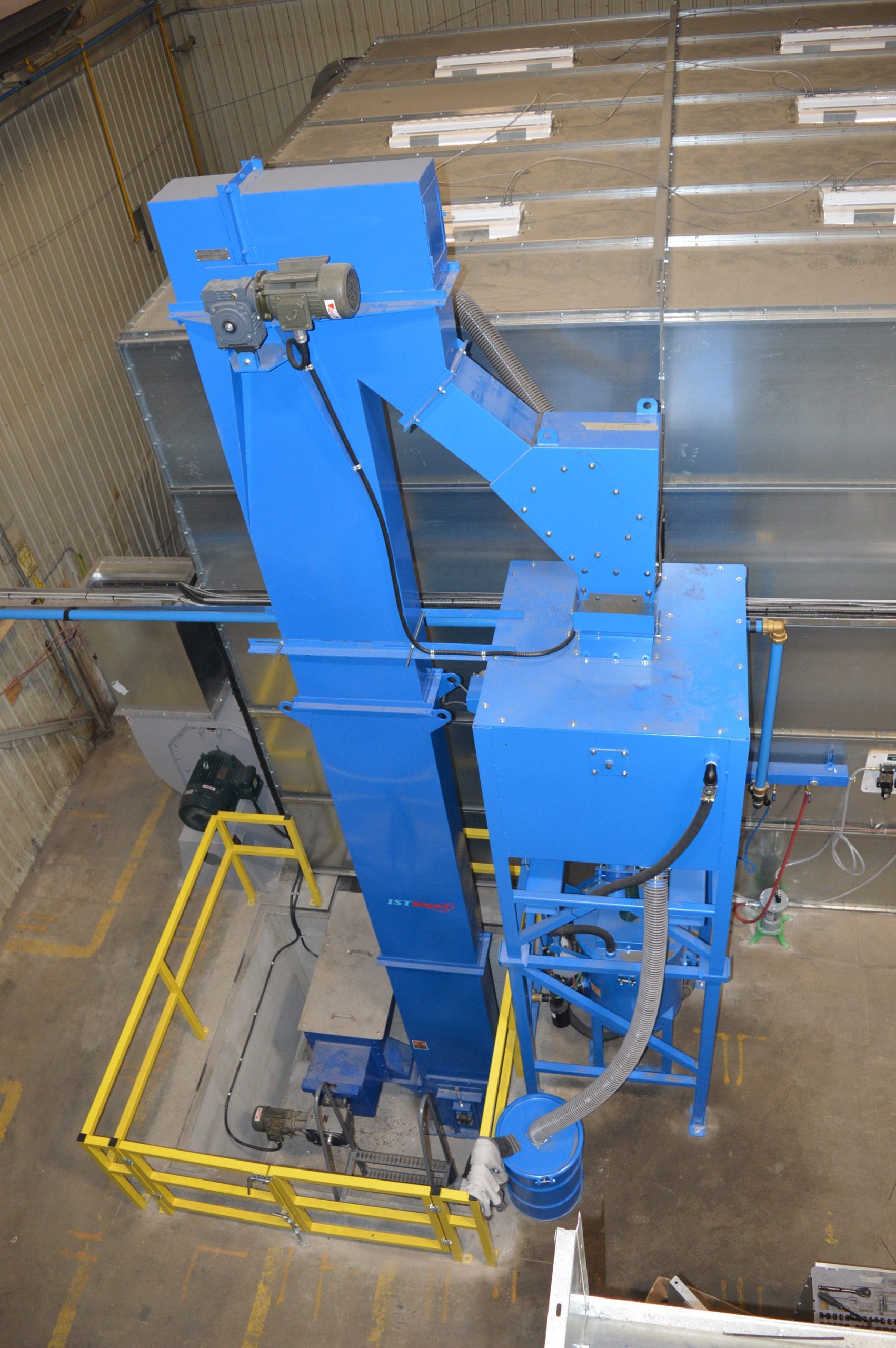
The air wash system drives adjustable airflow through the abrasive media stream falling by gravity in order to remove dust and fine particulate matter from media still in good working condition. A set of adjustable deflectors also allow for a better control of the media fall for an optimal cleaning result of the dirty media mix.
When the dirty media mix exits the air wash separator system, it has three possible outcomes:
Improperly configured airflow and deflectors will either divert good reusable media into the rejection barrel, or rather the opposite, allow shattered blast media and large pieces of processed by-products to fall down into the pressure blast pot.
However, you do not have to worry about this. The airflow only needs to be set once, and this is part of the machine startup procedures that will be handled by our qualified technicians. Also, since potentially harmful large pieces of debris are removed before they enter the bucket elevator, there is no risk of wearing out your blasting equipment at this point. It is solely a question of process optimization by allowing only abrasive media still in optimal working condition to reach the blast pot.
ISTblast offers different storage hoppers ranging from 6.4 cu. ft. to over 100 cu. ft. The storage hopper is usually located between the air wash separator and the pressure blast pot to temporarily stock an abrasive media reserve in order to refill the blast pot when it runs out of media.

Therefore, the storage hopper provides additional blasting autonomy, allowing for uninterrupted blasting operations. A 6.4 cu. ft. pressure blast pot allows for approximately 50 minutes of blasting autonomy, and when the blast pot runs empty, the blaster must simply depressurize it in order to refill it with media.
A full-floor recovery system only requires a 6.4 cu. ft. storage hopper to run uninterrupted blasting operations. This system continuously collects abrasive media after contact with the workpiece and unceasingly feeds the recovery system. Therefore, by the time the 6.4 cu. ft. blast pot runs empty, the 6.4 cu. ft. storage hopper is full and ready to refill the pot. Not only does the full-floor recovery system maximize the blaster’s productivity and reduce the effort by eliminating the need to load the floor hopper manually, it also allows for a more compact system and a significantly reduced amount of circulating abrasive media into the system – usually, 2.5 times the blast pot, so approximately 16 cu. ft. of media.
On the other hand, partial floor coverage requires a much bigger storage hopper since that the operator must shovel residual abrasive media down the hopper to feed the recovery system, and eventually the storage hopper. Therefore, the size of the storage hopper must be oversized to at least 10-to-30 cubic feet if the operator wants to refill the blast pot without cleaning the floor each time it runs empty.
A mechanical loading recovery system has the advantage of using a powerful mechanical loader to clean the floor. Then, the amount of residual abrasive media left on the floor is not a concern as it is with traditional systems where the operator must manually shovel the blast media into the hoppers. However, to ensure uninterrupted blasting operations, the storage hopper must be able to hold enough abrasive media to last a day or two. So, a very large 50-to-100 cubic feet storage hopper is advised in this system.
Oversizing the storage hopper results in elevating the bucket elevator accordingly and feeding the system with more abrasive media.
In summary, the desired size of the storage hopper – in other words, the number of refilling cycles desired without the need to clean the floor – sets the minimum ceiling clearance for the bucket elevator, which is the highest component of the mechanical recovery system, as well as the required quantity of media in circulation.
IST offers two different variations of the mechanical abrasive recovery systems to accommodate a large variety of applications and blast facilities. All of our systems can be tailored to your specific process objectives and installation constraints.
The excavated screw conveyor system combined with the bucket elevator is the ideal solution for maximizing the operator’s productivity, along with minimizing the required care and maintenance of the blast booth components. This system is suitable for large or small rooms, and offers flexibility in terms of recovery speed and floor layouts.
It provides an exceptional abrasive media recovery rate, without any restrictions when it comes to the media type or how harsh the application might be. Although it is the most expensive system to implement, it provides a quick return on investment when considering the overall costs of operation and maintenance of the blasting process.
The mechanical loading recovery system is suitable for extremely large abrasive blast rooms with limited budgets, or to maximize productivity in blast facilities where excavation is not permitted.
With this abrasive recovery system, residual abrasive media must be collected from the floor and loaded into the system by the means of a mechanical loader. It is inexpensive to implement and maintain since it only has a few mechanical components, which are located above-ground.
Some blast booth installations are limited in space, or the floor cannot be excavated due to landlord restrictions or environmental constraints. In most situations, a hybrid system can offer the same small-footprint installation as a pneumatic system, and still deliver the same performance as a mechanical system.
This solution is also ideal for subcontracting companies who may need to change abrasive media every once in a while or for applications which generate a significant amount of contaminants that could clog a regular pneumatic floor system.
The hybrid abrasive media recovery system consists of a screw conveyor floor hopper system meant to collect abrasive media remains, offering unlimited floor layout options. However, rather than using a bucket elevator and an air wash to clean and recycle used abrasive media, a ductwork is fitted to the end of the screw system to bring the abrasive media up to a cyclonic separator. Nevertheless, this system has the same limitations as a pneumatic system in terms of not being able to carry heavy media.
Read more about the Hybrid Pneumatic/Mechanical Recovery System.
Do not hesitate to contact our experts to discuss your options. We have tailored and designed numerous solutions and workarounds to accommodate particular space constraints.
Abrasive Blast Room (ISTblast)
Welcome to our website: istsurface.com
We respect your privacy.
We use cookies to enable you to navigate efficiently and to optimize the functionality of the site. By clicking "Accept", you consent to our use of cookies. Failure to consent or withdrawing consent may have an adverse effect on certain features and functions.
"*" indicates required fields